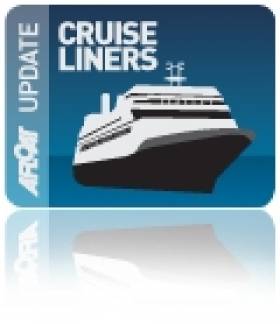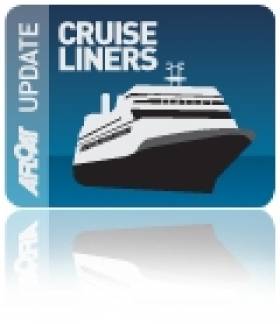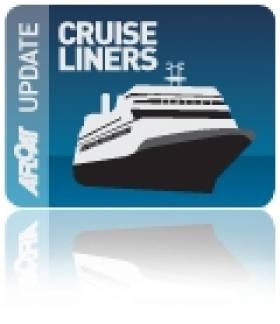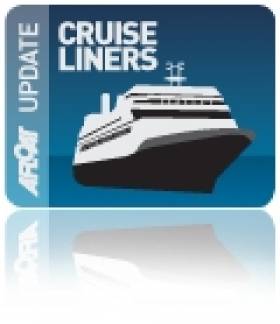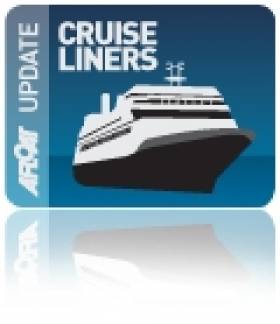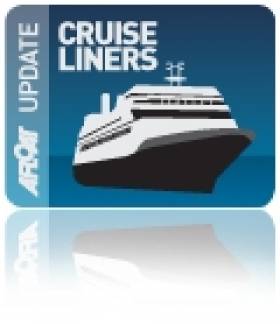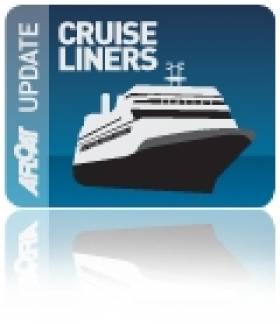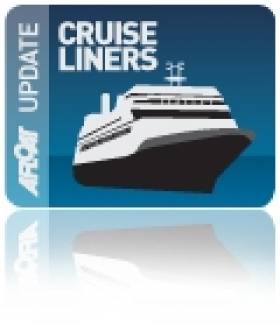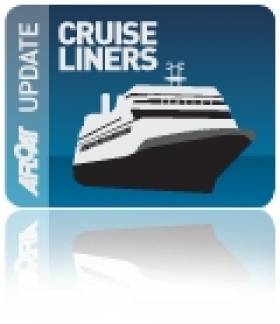Displaying items by tag: Cruise Liners
#CruiseBerthPlans – The Herald writes that from today plans for a controversial jumbo cruise ship facility in Dun Laoghaire harbour will go on public view.
The Dun Laoghaire Harbour Company (DLHC) lodged (last Friday as previously reported on Afloat) a planning application for the upgrade of the harbour with An Bord Pleanala at a cost of €100,000.
Prior to lodging the application, the company held a three-week public consultation period earlier this year. It said that 139 people made submissions - the vast majority of which (104) were opposed to the plans.
However in its application to the planning authority, the DLHC has said that most of the concerns expressed by people were based on misunderstandings about the plans.
The company prepared a response to these concerns addressing the most common issues, including the perception the plans would bring no economic benefit or would negatively impact on harbour users.
In a comprehensive Environmental Impact Statement, the company proposed that there would be no major, lasting negative impact to the users or the environment of the harbour.
However it did acknowledge that the jumbo cruise ships would "have a significant impact on all existing views towards the harbour".
"A proportion of existing harbour users may consider the sheer scale of the docked ship to be negative given that the vast majority of other vessels using the harbour are small by comparison," it said.
For more on this story, click Here.
#CruiseConsultation - Gillian Mills of Inshore Ireland writes that Dún Laoghaire/Rathdown Independent Councillor, Victor Boyhan has called for an oral hearing of a planning application for a major cruise berth terminal that was lodged today (last Friday) by Dún Laoghaire Harbour Company.
The eight-year, €18m strategic infrastructure development, comprising a 435m pier with an underpass, ancillary site and landscape works, will accommodate 'next generation cruise ships', according to the Dún Laoghaire Stakeholder Group.
To qualify as an SID, a proposed development must first come within the scope of one or more of the classes outlined in the 7th Schedule to the 2000 Act, and comply with the thresholds contained therein.
In addition, the Board must come to the opinion that the proposed development, if carried out, would fall within one or more of the following:
• is of strategic economic or social importance to the State or the region in which it would be situate
• would contribute substantially to the fulfilment of any of the objectives of the National Spatial Strategy or any regional planning guidelines in respect of the area or areas in which the development would be situate
• would have a significant effect on the area of more than one planning authority
The opinion is formed by the Board at the conclusion of the pre-application stage.
Inshore Ireland has much more on the proposed cruise-berth facility and details of observations / submissions to be made to An Bord Planeala during the seven-week consultation period, click here.
#ProposedCruiseDock- Calls on the Welsh Government to help develop a purpose built cruise ship dock at Holyhead on Anglesey amid concerns that the region could be missing out on valuable tourism cash.
The Daily Post which has more on the storey reports that the proposed development comes weeks after a vessel carrying 2,500 passengers failed to dock at the former Anglesey Aluminium jetty because it isn't suitable for use in high winds.
The Celebrity Silhouette (which called first to Dun Laoghaire on 14 June) was the largest vessel due at the Anglesey port this summer - one of more than 20 cruise ships coming to the island.
Anglesey AM Rhun ap Iorwerth expressed his disappointment that the island, and North Wales as a whole, missed out on thousands of pounds which would have been pumped into the local economy and has now called on the Welsh Government to intervene.
As reported today on Afloat.ie, the Dun Laoghaire Harbour Company on behalf of Dun Laoghaire Cruise Stakeholder Group will tomorrow (Friday 3rd July) submit its planning application for a new cruise berth facility at the Irish harbour to An Bord Pleanála
#CruiseTurnAround- Dun Laoghaire Harbour acted as a turnaround port of call for Windstar Cruises as the sail-assisted five-mast flagship Wind Surf ended and began fly-cruises yesterday, writes Jehan Ashmore.
Wind Surf berthed at the Carlisle Pier where passengers arrived and departed on the turnaround cruises. As she lay moored the French built ship which has 50 metre high masts stood higher than the height of the new landmark building of the DLR LexIcon Library.
Today, the 187m long vessel is on an anchorage call in Douglas Bay, Isle of Man marking the first leg of her cruise.
Cruise-goers mostly from the US and Canada had disembarked the 14,475 tons Wind Surf during her Dun Laoghaire call (albeit having arrived on Sunday, a day early than scheduled). She had begun a cruise in Lisbon, Portugal. Likewise on this current cruise passengers are in the majority from the North American market.
The Carlisle Pier is where the former conventional ferry served until 1996. In that same year the carferry was replaced by the Stena HSS fast-ferry that too came to an end with operations closing last year.
Dun Laoghaire may no longer have a ferry service with Holyhead in north Wales, though it was interesting to observe that the 'check-in' facilities for the cruise took place in the former Stena Line terminal reception hall. The terminal located on St. Michaels Wharf is adjacent to the Carlisle Pier.
A cruise representative informed me that expectant cruise-goers had flown in to Dublin Airport. Some of the visitors had spent several days in the capital in advance to embarking on the cruise.
The use of the redundant ferry terminal for the turnaround cruises has taken place in previous seasons by Windstar Cruises. The US cruise firm with corporate office based in Seattle have been the most frequent operator that is to dock inside the harbour since 2012.
#DivertedCruiseShip – A sail-assisted five mast cruiseship with up to 310 passengers was forced to cancel an anchorage call off Dunmore East today due to strong winds and divert to Dun Laoghaire Harbour, writes Jehan Ashmore.
Unfavourable winds early this morning off Dunmore East prevented the transfer of passengers ashore by tenders from the 14,745 gross tons Wind Surf. Instead the flagship of Windstar Cruises which boasts five towering masts (each 50m high) made the passage to Dublin Bay later today with a mid-afternoon arrival.
It would be further two hours before she finally docked within Dun Laoghaire Harbour at 5pm following berthing safety procedures that required having to call out a tug from Dublin Port.
Once inside Dun Laoghaire Harbour the Wind Surf (if to include the bowsprit is 187m long) was understood given asistance by the tug, Beaufort. This enabled Wind Surf to approach astern alongside Carlisle Pier that is adjcent to the East Pier and jetty structure.
It was a case of déjà vu as only last week the 116 passenger Island Sky as previously reported on Afloat.ie had required the same tug service. On that occasion, it transpired once inside the harbour, weather conditions did not require tug assistance as Island Sky managed under own her power to berth at Carlisle Pier.
The delays to Wind Surf passengers from making a port of call to the south-east is somewhat offset as the French built vessel is to spend an overnight call tonight in Dun Laoghaire. Wind Surf as it happens was already scheduled to call to the harbour tomorrow morning.
On previous calls to Dun Laoghaire Wind Surf has self-unfurled her triangular sails by computer operated winches when departing the harbour. So hopefully this will be repeated as strollers stride the pier tomorrow (Monday) when she is due to depart at 6 o'clock.
Last week, a fleetmate Star Legend albeit a conventional cruiseship paid a visit to Dun Laoghaire Harbour and likewise at Carlisle Pier.
Only the smaller shallow draft cruiseships can be accommodated inside the harbour. Of the 18 cruise calls expected this record breaking season, only four will make an in port of call as much larger deep draft cruiseships have to anchor offshore.
If Star Legend seems familiar the almost 10,000 tonnes cruiseship visited the harbour last season. The 212 guest vessel had been under the banner of Seabourn Cruises which sold the Seabourn Legend to Windstar.
She belongs to a trio of sisters that were all sold and renamed as part of Windstar Cruises mixed fleet of vessels.
Gloria’s Magellan Makes Maiden Call to Dublin Port
#NewCMVflagship- Magellan which was named by TV and radio personality Gloria Hunniford earlier this year, made her maiden call to Dublin Port this morning for UK based Cruise & Maritime Voyages, writes Jehan Ashmore.
The 46,052 tonnes Magellan is on charter from Carnival Corporation to CMV as their new flagship for the 2015 and 2016 seasons.
Carnival, the US cruise giant operator commissioned the Danish yard of Aalborg Vaerft to launch her as Holiday in 1985 as part of new generation of cruiseships that began with Tropicale. In 2010 the 9 passenger decked Magellan had a rebuild but still she retains her distinctive winged funnel design.
Magellan is marketed for adults-only (16 years plus) cruises. She has a capacity for approximately 1,250 passengers accommodated in 726 cabins. Among these cabins are 14 featuring balcony suites.
When it comes to dining options, there is the Waldorf and Kensington Restaurants offering two sitting dining or the more informal Raffles Bistro. Throughout the intimacy found on Magellen are comfortable lounges and for entertainment is the two-tier theatre style Magellan Show Lounge.
As Afloat reported back in November, Magellan offers expansive timber deck areas not to be found on 'mega' cruiseships. Also on these outside decks are two swimming pools and a choice of three whirlpools.
For the two seasons CMV are to have Magellan based out of Newcastle-upon-Tyne and Tilbury. The port on the Thames estuary is where as previously mentioned Gloria Hunniford had the honour as the ships Godmother by naming the new CMV flagship in March.
Today her fleetmates Marco Polo, Azores and Astor in that order are visiting the following locations Leith, Scotland, Lerwick in the Sheltand Islands and Kristiansand in Norway.
The crew of Magellan are British officers and deck ratings are international personnel. The 222m cruiseship docked in Alexandra Basin and is scheduled for a departure later this afternoon.
#CruiseHarbour – Island Sky, the first cruiseship to dock inside Dun Laoghaire Harbour this season had requested tug assistance in preparation to berthing within the port this morning, writes Jehan Ashmore.
Overnight, the Italian built vessel with a 116 passenger capacity had sailed from Waterford city quays and upon arrival in Dublin Bay had picked up a pilot from a cutter launch around 07.30.
For around the next two hours Island Sky circled the centre of the bay before Beaufort, a Dublin Port Company tug came on the scene to escort the 4,200 tonnes vessel into Dun Laoghaire Harbour.
The requirement of the tug was understood to be precautionary due to strong winds expected inside Dun Laoghaire Harbour during the berthing of the 90m Island Sky.
It transpired the Island Sky managed to moor alongside the harbour's Carlisle Pier opposite the East Pier using her own power alone that included a bow-thruster. This avoided the services of Beaufort which saw the tug remain in attendence at close proximity.
As Island Sky came astern at Carlisle Pier a fleet of awaiting coaches were there to transport passengers to Malahide Castle. Also heard on the PA system on board the Noble Caledonia operated cruiseship was the option to take a trip into Dublin using the DART railway whilst others simply strolled to the nearby attractions of Dun Laoghaire.
Following today's shore excursion, passengers will be returning to the Island Sky which has accommodation in the form of 57 suites all with outside views and located over five decks. On the Erikson and Explorer decks these suites feature private balconies.
Asides Island Sky's call, the Dun Laoghaire Harbour Company have a further three similar 'harbour' calls scheduled but by another pair of cruiseships. Star Legend is to call twice with an interim visit by Wind Surf. The sail-assisted cruiseship has been the most frequent in port caller of recent years.
In total 18 cruiseships are due this year with the majority of the larger and deep draft cruiseships having to anchor offshore with passengers tendered ashore by launches.
Killybegs First P&O Cruises Caller Sets Sail
#KillybegsP&O - Killybegs first visitor from P&O Cruises, the 30,000 tonnes Adonia set sail last night as a lone piper played on the pier to mark her departure.
Adonia had arrived in the port yesterday morning with about 700 passengers on board.
The master of the cruiseship, Captain David Box, called in at the Killybegs Information Centre and presented a commemorative plaque to Manager, Anne Dorrian, and the team.
For more on the debut call of the prestigious cruise operator, see yesterday's DonegalNow.com
Another P&O caller and the largest ever cruiseship due to Killybegs as Afloat previously reported is the 69,000 tonnes Oriana on 26 June.
The 1,800 passenger ship is one of a record breaking season of eight cruise callers this year to visit the north-west port.
#CruiseConcerns – One of the country's main ports is due to lodge a multi-million development bid with An Bord Pleanala in the next ten days, writes the Herald.ie
The controversial Dun Laoghaire planning application, which has been met with opposition from residents and several local political representatives, is being submitted by Dun Laoghaire Harbour Company.
The harbour company is seeking permission for an €18m cruise berth facility to cater for jumbo cruise ships, which would mean passengers will be able to walk on to the port.
The company hopes the cruise berth will be a boost for the local economy, as predicted in studies carried out so far.
For more on the story, click here.
#CelebrityCaller- Celebrity Cruises, the brand with the iconic 'X' on their funnels are the next operator to visit Dun Laoghaire Harbour when Celebrity Silhouette makes her maiden call offshore of the port next Sunday, writes Jehan Ashmore.
The call of the 122,400 tonnes 'Solstice' class cruiseship with an occupancy capacity of 2,886 passengers has been greeted by the Dun Laoghaire Cruise Stakeholder Group which will be putting into place a welcome programme for the arrival of the operator whose origins are from the Greek Chandris Group. They had ships with a chi, a letter of the Greek alphabet on their funnels, in which the tradition continues as in the case of the 'Silhouette' which has a pair of funnels like those liners of the past.
As the cruise-class name suggests, the 'Solstice' was the first in the industry to utilize solar technology and where some of the solar panels provide shade within the ship's Solarium. The power is also used on the 318m long Celebrity Silhouette for energy production.
Also this month, the intimate 310-guest Wind Surf makes a return visit this year on 29 June. The distinctive five-masted Windstar Cruises vessel that has computer-assisted sails will also be the attention of the DCSG as specially devised events are organised (to season ending September) to ensure passengers take the maximum advantage of what the town has to offer.
Wind Surf which is only 162m long has been the most frequent 'in-harbour' caller since the cruise business was revived in the south Dublin Bay port in 2011.
It was in 2002 that Celebrity Cruise made a previous call off Dun Laoghaire Harbour with the 294m 'Millennium' class Constellation. She made for then an impressive debut as the 90,000 tonnes cruiseship (renamed in 2007) anchored offshore during an inaugural cruise of north-west Europe.
This year's record season of 22 cruise calls for Dun Laoghaire Harbour has fallen to 18 as previously reported on Afloat.ie. Cancellations were made twice by MSC Splendida and likewise of Royal Princess which together have favoured Dublin Port instead as this avoided tendering passengers ashore and allowing more time for guests to spend time in the capital.
It transpires that the 137,000 tonnes MSC Splendida however will finally make a debut at anchor off Dun Laoghaire on 29 August. This will bring a boost to the harbour having firstly cancelled the opening cruise season call last month which led Royal Princess by default to launch the season on 12 May.
Royal Princess which is even larger than MSC Splendida in passenger terms with 3,600 as well as tonnage of 142,000 tonnes made her second docking in Dublin Port on Friday. The Princess Cruises giant berthed within Alexandra Basin.
The 19-deck cruiseship towered above the industrial skyline of the port estate where the new incinerator complex is currently under construction.


























